Oliverís Loops
Thursday 28 October 1999 - Thursday 4 November 1999
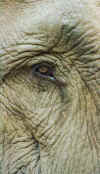 Another of Oliverís
suggestions had been a two day trip out into the mountains to some of the more
remote areas in adjacent Xayabury province, with a particular hope of seeing
some of the many elephants Lao villagers use as working animals out in the
jungle. Given how slow travel
upriver can be, we opted to take a speedboat.
We had already heard them tearing up and down the river on our previous
excursion and wondered how people could possibly stand the noise they made; we
soon realised that itís a small price to pay to whack the journey time
by half ... especially if you take the precaution of wearing ear
plugs!
Another of Oliverís
suggestions had been a two day trip out into the mountains to some of the more
remote areas in adjacent Xayabury province, with a particular hope of seeing
some of the many elephants Lao villagers use as working animals out in the
jungle. Given how slow travel
upriver can be, we opted to take a speedboat.
We had already heard them tearing up and down the river on our previous
excursion and wondered how people could possibly stand the noise they made; we
soon realised that itís a small price to pay to whack the journey time
by half ... especially if you take the precaution of wearing ear
plugs!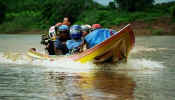
We arrived in the village of Ta
Sueng not having a clue how to get from there to our overnight stop miles away
in Pakbeng. Presumably
we looked as if we hadnít a clue as one of the guys who had been travelling
with us offered us a lift. We
gladly clambered into the back of his four-wheel drive and a few hours (and a few hundred pot holes) later
arrived at our destination. The
only hotel in town left a lot to be desired but for a few dollars a night and
cold running water, it was a bargain. The
next morning we met up with a friendly Swiss guy, Etienne, who 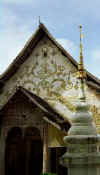 had also been
given Oliverís tip, and the three of us headed to the market to try and
acquire transportation to Muang Ngoen, which we had been told was home to more
than a hundred domesticated elephants used for logging and agriculture.
Animal activists, rest easy. These
people hold their elephants in high regard; so much so that there is an annual
ceremony held solely on their behalf!
had also been
given Oliverís tip, and the three of us headed to the market to try and
acquire transportation to Muang Ngoen, which we had been told was home to more
than a hundred domesticated elephants used for logging and agriculture.
Animal activists, rest easy. These
people hold their elephants in high regard; so much so that there is an annual
ceremony held solely on their behalf!
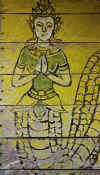 By now, we were totally off the
radar screen of even the guidebook and negotiations proved somewhat arduous as
none of us spoke any Lao, but after a couple of false starts, we finally got on
the right track and were in Muang Ngoen by early afternoon. The village is
situated very close to the Thai border and appeared to be more of a trading
point than anything else but it was a pleasant place to spend the day and take
in some rural Lao culture. After
finding ourselves somewhere to get a bowl of noodles, we wandered through the neighbouring fields and visited their beautiful
Wat Ban Kon, a traditional Thai-Lu (Green Thai) style temple where the monks still use
palm leaves to preserve their Buddhist texts.
And we were not disappointed on the elephant front either.
Not that we saw a hundred but enough to realise why these animals are so
important to the people in rural areas.
By now, we were totally off the
radar screen of even the guidebook and negotiations proved somewhat arduous as
none of us spoke any Lao, but after a couple of false starts, we finally got on
the right track and were in Muang Ngoen by early afternoon. The village is
situated very close to the Thai border and appeared to be more of a trading
point than anything else but it was a pleasant place to spend the day and take
in some rural Lao culture. After
finding ourselves somewhere to get a bowl of noodles, we wandered through the neighbouring fields and visited their beautiful
Wat Ban Kon, a traditional Thai-Lu (Green Thai) style temple where the monks still use
palm leaves to preserve their Buddhist texts.
And we were not disappointed on the elephant front either.
Not that we saw a hundred but enough to realise why these animals are so
important to the people in rural areas.
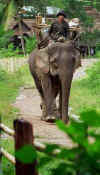
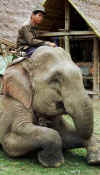
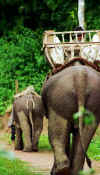
The following day, we made our
way back to Ta Sueng, this time by local transportation Ė over twenty people
in the back of a covered truck, 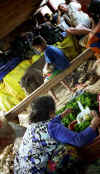 not counting those either sitting on top or
hanging on for dear life at the back. At
Ta Sueng we parted company with Etienne; he was heading upstream to cross over
into Thailand; we were heading back to Luang Prabang before branching out on
another 'off the beaten track'
not counting those either sitting on top or
hanging on for dear life at the back. At
Ta Sueng we parted company with Etienne; he was heading upstream to cross over
into Thailand; we were heading back to Luang Prabang before branching out on
another 'off the beaten track'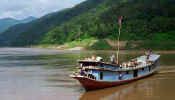 adventure on our way back to Vientiane.
adventure on our way back to Vientiane.
The boat trip back down river
was hysterical. Not at all
comfortable and seemingly endless but in between the local ladies drying their
river weed (presumably they were taking it down to Luang Prabang to sell),
locals dragging livestock aboard to ship to market and meeting a few new faces,
there was quite a lot to keep us entertained.
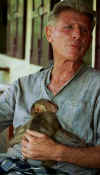 Back in Luang Prabang, we headed
for the nearest restaurant and filled up on laap (the best dish we had on
our entire trip, consisting of minced lamb, fresh herbs and chilies) and many
other local delicacies we had missed after two days on noodles and inedible-looking
vegetables wrapped up in plant leaves. With
only a day's stop over, we had just enough time to say
Back in Luang Prabang, we headed
for the nearest restaurant and filled up on laap (the best dish we had on
our entire trip, consisting of minced lamb, fresh herbs and chilies) and many
other local delicacies we had missed after two days on noodles and inedible-looking
vegetables wrapped up in plant leaves. With
only a day's stop over, we had just enough time to say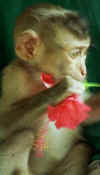 our goodbyes to Oliver
and Bonnie before we were back on the road again.
our goodbyes to Oliver
and Bonnie before we were back on the road again.
From Luang Prabang we took a
local bus back to Xayabury, but this time towards the provincial capital.
Local buses tend to leave when theyíre full as opposed to on schedule
so we got there early to claim our seats rather than be the last two to make up
the numbers and have to hang off the back!
From experience, we had learned that there didnít seem to be a limit to
the maximum number of people you could fit into a vehicle regardless of how big
or small, and it always amused us to see how many more people the driver would
squeeze on board once it was already full to overflowing.
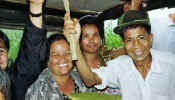 Our journey was interrupted by a
river crossing and by the time we had reached the other side, the rain was
teeming down and we were the last people to the trucks, being offered
ďseatsĒ standing on the rear bumper and hanging onto the roof.
We politely declined. Instead,
we hitched a lift with a Korean businessman who presumably took pity on us given the state of the weather.
He was in Laos looking for five elephants to buy and ship back to Korea
to a game park he and his company were developing there. We had no idea what the price of an elephant was, but we did
find out that it costs over $15,000 to fly them to Korea.
Good luck to him!
Our journey was interrupted by a
river crossing and by the time we had reached the other side, the rain was
teeming down and we were the last people to the trucks, being offered
ďseatsĒ standing on the rear bumper and hanging onto the roof.
We politely declined. Instead,
we hitched a lift with a Korean businessman who presumably took pity on us given the state of the weather.
He was in Laos looking for five elephants to buy and ship back to Korea
to a game park he and his company were developing there. We had no idea what the price of an elephant was, but we did
find out that it costs over $15,000 to fly them to Korea.
Good luck to him!
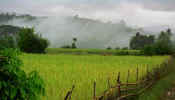
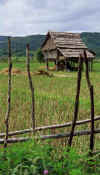 Despite its proximity to the nationís capital and its
location bordering Thailand, Xayabury is one of the most
remote provinces in Laos.
Itís extremely mountainous and as we were to find out, devoid of
vehicle roads except for one north-south route.
The provincial capital had little of interest but there were a couple of wats to explore complete with
monks keen to practice their English. The
next day, we were on the move again, packed into the back of yet another local 'bus' to Pak Lai where we hoped to be able to pick up a boat all the way
down the Mekong to Vientiane. As
there were no other people wanting to travel downriver, we were left with the
option of waiting a day or hiring the whole speedboat to take us there.
We dug deep into our pockets and opted for the latter, and over pasta and
wine in the capitol that night it seemed a brilliant decision.
Despite its proximity to the nationís capital and its
location bordering Thailand, Xayabury is one of the most
remote provinces in Laos.
Itís extremely mountainous and as we were to find out, devoid of
vehicle roads except for one north-south route.
The provincial capital had little of interest but there were a couple of wats to explore complete with
monks keen to practice their English. The
next day, we were on the move again, packed into the back of yet another local 'bus' to Pak Lai where we hoped to be able to pick up a boat all the way
down the Mekong to Vientiane. As
there were no other people wanting to travel downriver, we were left with the
option of waiting a day or hiring the whole speedboat to take us there.
We dug deep into our pockets and opted for the latter, and over pasta and
wine in the capitol that night it seemed a brilliant decision.
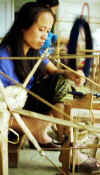 Our next stop was to be Vietnam.
We booked our flights and had a day in Vientiane to take another look
around, this time with a primary focus on the souvenir
Our next stop was to be Vietnam.
We booked our flights and had a day in Vientiane to take another look
around, this time with a primary focus on the souvenir 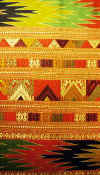 shops.
One of our greatest finds was a textile shop owned and run by Carol
Cassidy, a Yankee who has devoted her life to textile design and weaving. She now lives in Laos and, using local weavers, takes
traditional Lao designs and creates first-class contemporary weavings. We have just
received the wall hanging she designed for us, and it is exquisite.
shops.
One of our greatest finds was a textile shop owned and run by Carol
Cassidy, a Yankee who has devoted her life to textile design and weaving. She now lives in Laos and, using local weavers, takes
traditional Lao designs and creates first-class contemporary weavings. We have just
received the wall hanging she designed for us, and it is exquisite.
The following day, with bags
packed and two hours to our flight, we saw on CNN that Vietnam was suffering
from heavy rainfall and parts of it were under 3 metres (10 feet) of water.
Not having brought wellies, we decided to re-route and feeling in need of
some sun and relaxation, opted for a flight to Bangkok and then on to Phuket.
Just what the doctor ordered. Or so we thought . . .